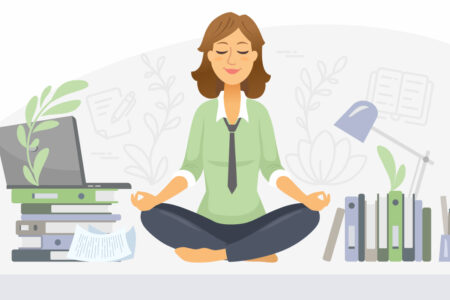Some things are better in person: comparing online and in-person mindfulness meditation
Mindfulness meditation has received increasing research interest over the last 20 years. Thanks to mindfulness apps, stress relief is available to everyone, at our fingertips. But how does this experience compare to ‘old-school’ mindfulness meditation?
Mindfulness meditation originates in Buddhist practices stretching back 2500 years. It emphasizes being present in the moment by non-judgmentally attending to one's thoughts, feelings, and sensations. The practice of mindfulness meditation for medical purposes was popularized during the late 1900s by Jon Kabat-Zinn. He and his colleagues developed the Mindfulness-Based Stress Reduction (MBSR) approach, which is used across various settings within the field of psychology for both chronic issues and prevention practices. Recent years have also seen the emergence of freely available online mindfulness packages and apps. With the number of published papers on MBSR increasing yearly, and the world becoming increasingly digitalized, it is important to understand the effects of mindfulness meditation via online adaptations.
Mindfulness meditation
MBSR is generally an 8-week program involving both guided sessions and home practice meditation. It targets the improvement of psychological well-being and life satisfaction through formal and informal practices which lead to a general reduction in stress levels. MBSR and its success regarding stress reduction when practiced in person is substantially documented. Online adaptations of mindfulness programs seem to be highly appealing, too, with over 52 million users across the top 10 mindfulness apps. The extent to which the findings about in-person MBSR also apply to the online world, however, is a matter of discussion.
Mixed results for online meditation
Research investigating the effects of mindfulness apps has found a significant decrease in app users’ perceived stress levels, as well as an increase in mindfulness. While this finding is common, evidence on the apps’ effects concerning psychological well-being and life satisfaction is either missing or inconsistent. Additionally, research directly comparing in-person and online mindfulness practices was almost nonexistent until one study from 2022 investigated this problem.
When the study compared the effectiveness of MBSR delivered in person to that delivered online, it found a discrepancy between perceived stress changes and life satisfaction. Perceived levels of stress decreased in both conditions, but overall life satisfaction only improved for the in-person condition. This is an interesting finding, but a curious one, given that the aim of MBSR is to increase life satisfaction by decreasing perceived stress. What does it mean if an individual’s perceived stress decreases, but this does not result in better life satisfaction? It thus remains questionable whether online MBSR adaptations are effective, and there is still much to be learned about this topic.
Objective vs subjective stress
These findings also shed light on another interesting debate: objective vs subjective stress. Subjective stress is measured using various internal tests (e.g., self-reports or questionnaires), whereas objective stress can be measured using physiological tools (measuring heart rate variability, blood pressure, and various hormonal changes). Most studies investigating MBSR or mindfulness meditation have focused on the evaluation of individuals’ subjective stress levels. Nonetheless, physiological markers of stress have also been shown to decrease as a result of mindfulness meditation.
Other research has found evidence of a link between thought content and daily levels of cortisol, one of the stress hormones, this suggests that thought patterns can significantly affect physiological stress levels. Since mindfulness emphasizes focusing on one’s awareness of the present moment, including thought content, this research could demonstrate the importance of measuring stress objectively.
Setting matters
The setting in which one practices mindfulness meditation may also play a role. Meditation in natural settings has many benefits. For example, the meditation process is facilitated by the perceived restorativeness of the environment: its potential to reestablish certain cognitive capacities. Furthermore, meditation in natural scenery has been positively linked with a decrease in cognitive demand and attentional load. This suggests that the setting in which one practices meditation significantly affects the ability to engage in mindfulness and truly benefit from its advantages. As not everyone can walk outside and have access to restorative natural scenery, however, other solutions must be found.
Future expectations
One interesting future avenue for this subject is the use of virtual reality (VR). VR is a computer-generated artificial three-dimensional sensory environment that allows users to interact with a simulated environment of their choice. It has been found to enable an adaptive experience based on bio- and neurological feedback. Additionally, compared to just guided-audio meditation, the immersiveness of a VR experience has led to a greater experienced state of mindfulness. However, research regarding general meditation using VR is not rigorous enough. Most studies fail to mention the type of meditation used, and others only look at the immersiveness of VR, rather than its psychological effects such as stress reduction. A lot is still to be learned about the use of VR in assisting mindfulness meditation, but the future possibilities are promising.
In the meantime, why not try taking your mindfulness app for a restorative walk through nature.





